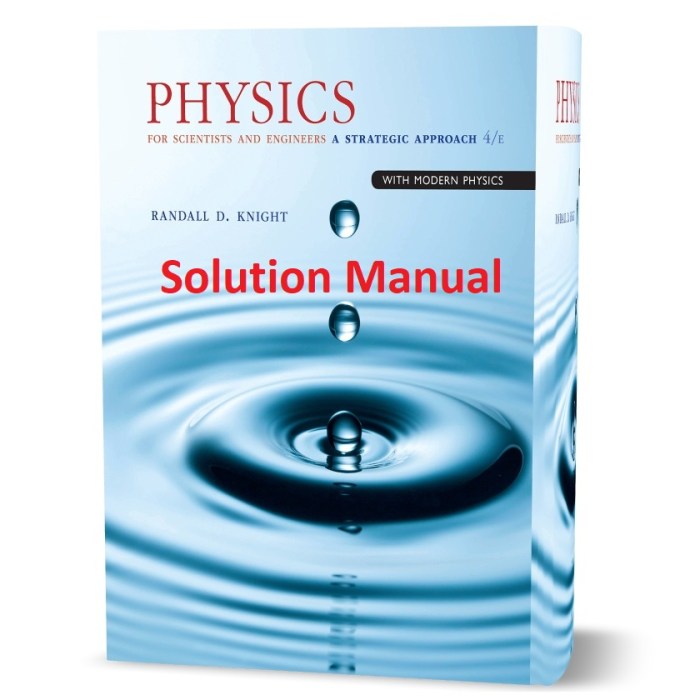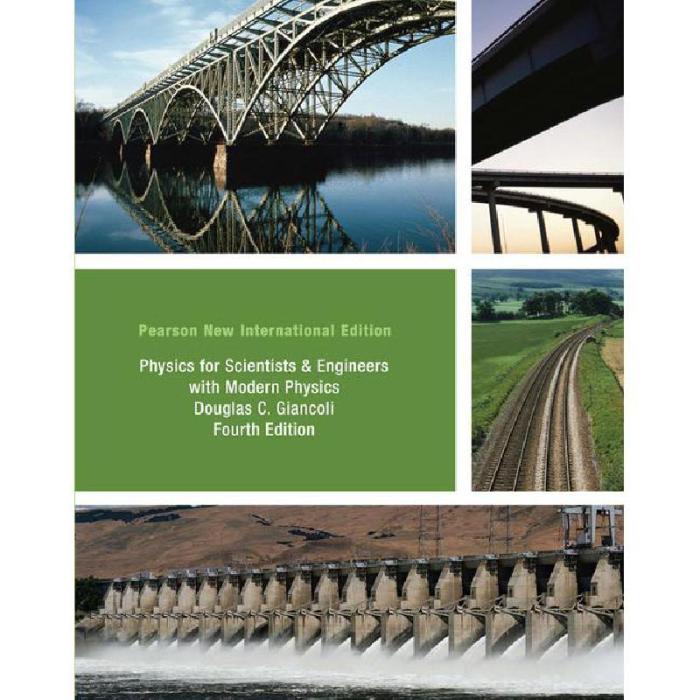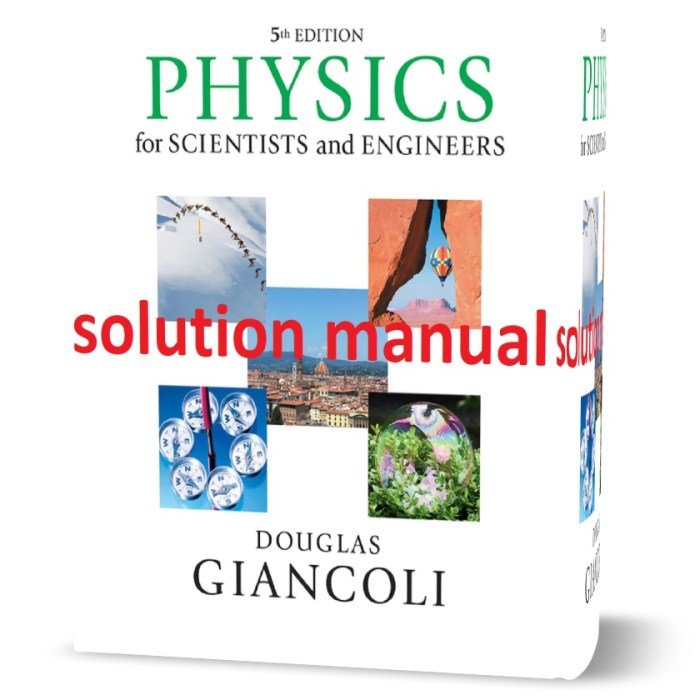Physics for scientists and engineers giancoli fourth edition – Giancoli’s Physics for Scientists and Engineers, Fourth Edition, is a comprehensive textbook designed for undergraduate students pursuing science and engineering degrees. Written by renowned physicist Douglas C. Giancoli, this extensively revised edition provides a clear and accessible introduction to the fundamental principles of physics, offering a solid foundation for students’ future studies and careers.
The book’s logical organization and engaging narrative style make complex concepts easy to grasp, while its numerous examples and problem-solving techniques help students develop a deep understanding of physics and its applications in the real world.
Book Overview

Physics for Scientists and Engineers, Fourth Edition by Douglas C. Giancoli is a comprehensive textbook designed for undergraduate students majoring in science, engineering, and technology. It provides a thorough introduction to the fundamental principles of physics, emphasizing conceptual understanding and problem-solving skills.
The author, Douglas C. Giancoli, is a renowned physicist and educator with over 40 years of experience teaching physics at the university level. He is the recipient of numerous awards for his excellence in teaching and his contributions to physics education.
The book is organized into four parts: Mechanics, Waves, Thermodynamics, and Electricity and Magnetism. Each part is further divided into chapters, which cover specific topics within the broader subject area.
Key Concepts and Theories
The book covers a wide range of fundamental concepts and theories in physics, including:
- Newton’s laws of motion
- Energy and momentum
- Waves and optics
- Thermodynamics
- Electricity and magnetism
These concepts are essential for understanding the physical world and are applied in a wide variety of scientific and engineering fields.
Examples of Applications
- Newton’s laws of motion are used to design and analyze the motion of objects, such as cars, airplanes, and rockets.
- Energy and momentum are used to study the behavior of particles and waves, such as in particle accelerators and nuclear reactions.
- Waves and optics are used to design and analyze optical systems, such as lenses, telescopes, and lasers.
- Thermodynamics is used to design and analyze heat engines, refrigerators, and other thermal systems.
- Electricity and magnetism are used to design and analyze electrical circuits, motors, and generators.
Problem-Solving Techniques

The book teaches a variety of problem-solving techniques that can be used to solve physics problems effectively. These techniques include:
- Dimensional analysis
- Order-of-magnitude estimates
- Free-body diagrams
- Energy conservation
- Momentum conservation
These techniques are explained in detail and illustrated with numerous examples throughout the book.
Example of Problem-Solving Technique
Dimensional analysis is a technique that can be used to check the validity of a solution to a physics problem. It involves checking that the units of the solution are consistent with the units of the problem.
Applications in Science and Engineering
The concepts and theories covered in the book have a wide range of applications in science and engineering. Some examples include:
- In mechanical engineering, physics is used to design and analyze machines, structures, and vehicles.
- In electrical engineering, physics is used to design and analyze electrical circuits, motors, and generators.
- In chemical engineering, physics is used to design and analyze chemical processes and reactors.
- In materials science, physics is used to study the properties of materials and develop new materials.
- In biophysics, physics is used to study the physical properties of biological systems.
Physics is a fundamental science that is essential for understanding the physical world and for developing new technologies.
Pedagogical Features: Physics For Scientists And Engineers Giancoli Fourth Edition
The book includes a number of pedagogical features that enhance the learning experience, including:
- Over 1,000 worked examples
- Over 2,000 end-of-chapter problems
- Review questions at the end of each chapter
- A glossary of terms
- An index
These features help students to learn and understand the material more effectively.
Example of Pedagogical Feature
The worked examples provide step-by-step solutions to a variety of physics problems. These examples illustrate how to apply the concepts and theories covered in the book to solve real-world problems.
Comparison with Other Physics Textbooks
Physics for Scientists and Engineers, Fourth Edition by Douglas C. Giancoli is a well-respected textbook that is widely used in undergraduate physics courses. It is comparable to other popular textbooks, such as:
- Physics for Scientists and Engineers by Serway and Jewett
- Physics for Scientists and Engineers by Young and Freedman
- Physics for Scientists and Engineers by Halliday, Resnick, and Walker
Each of these textbooks has its own strengths and weaknesses. Physics for Scientists and Engineers, Fourth Edition by Douglas C. Giancoli is known for its clear writing, comprehensive coverage, and abundance of practice problems.
Visualizations and Illustrations

The book includes a large number of visualizations and illustrations that help to clarify the concepts and theories covered in the book. These include:
- Over 1,000 full-color figures
- Over 200 photographs
- Over 100 tables
These visuals help students to visualize the concepts and theories covered in the book and to understand how they apply to the real world.
Example of Visualization, Physics for scientists and engineers giancoli fourth edition
One example of an effective visualization in the book is the use of a free-body diagram to illustrate the forces acting on an object. This diagram helps students to visualize the forces and to understand how they affect the motion of the object.
FAQs
What are the key features of Giancoli’s Physics for Scientists and Engineers, Fourth Edition?
Giancoli’s Physics for Scientists and Engineers, Fourth Edition, is renowned for its clear and accessible writing style, comprehensive coverage of fundamental principles, engaging examples, and a wealth of problem-solving techniques.
How does Giancoli’s textbook approach problem-solving?
Giancoli’s textbook emphasizes a step-by-step problem-solving approach, guiding students through the process of identifying relevant concepts, setting up equations, and solving for unknowns. Numerous examples and practice problems reinforce this approach.
What are the applications of physics covered in Giancoli’s textbook?
Giancoli’s textbook explores the applications of physics in a wide range of scientific and engineering fields, including mechanics, thermodynamics, electricity and magnetism, optics, and modern physics. Real-world examples illustrate how physics principles are used to solve practical problems.